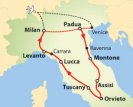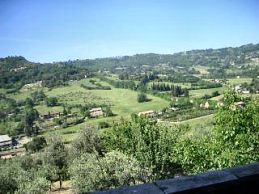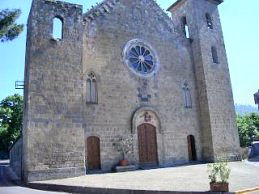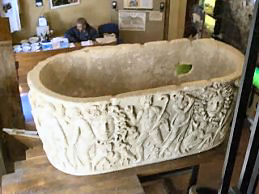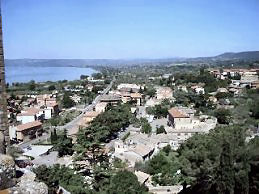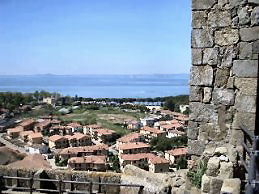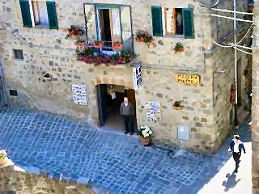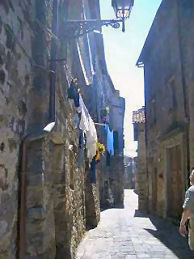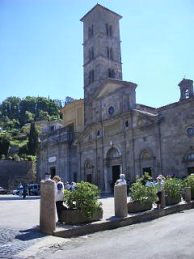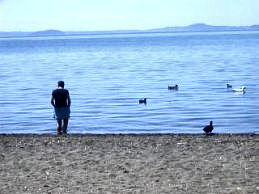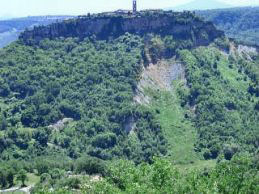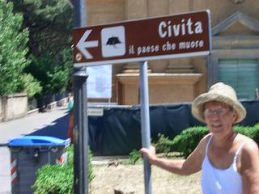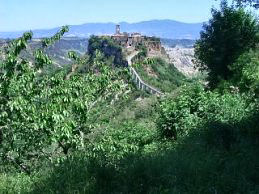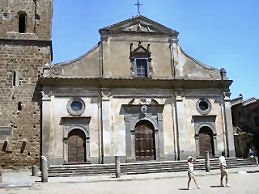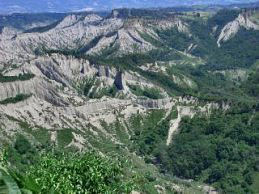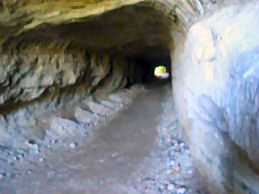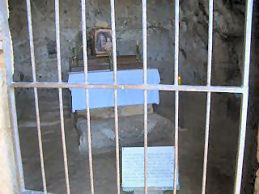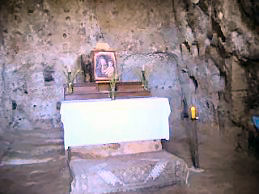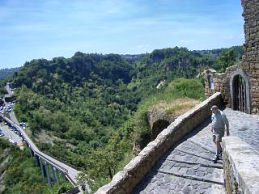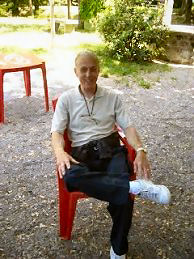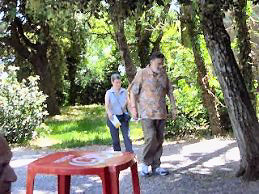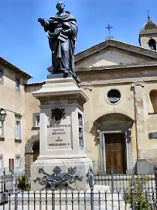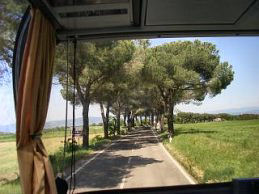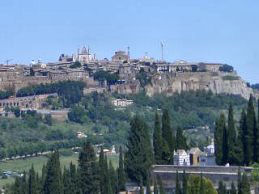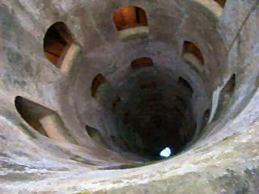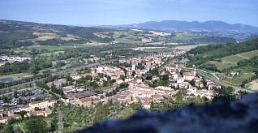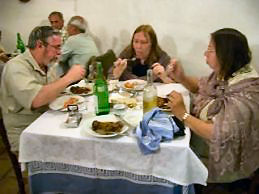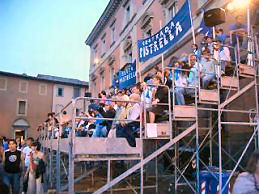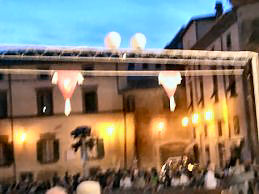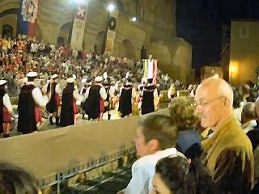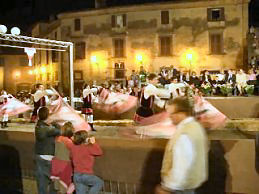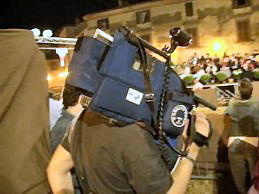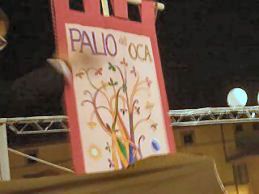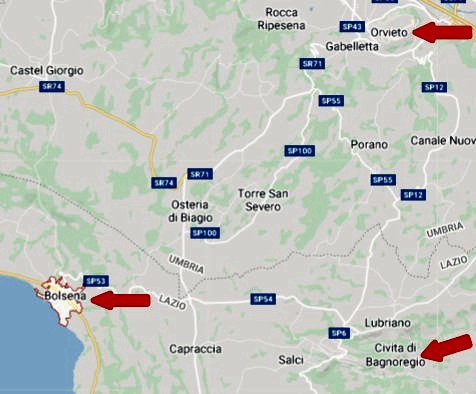
The birds woke me up at 5:30. I felt much better. In fact I was pretty certain that the back pain was going away. The only time that it has bothered me much in the last day or two was when I had to stand in one place for an extended period of time.
Breakfast was exceptionally good again. It included cereal, mixed fruit, hard-boiled eggs, salami and cheese sandwich stuff, juice, and cappuccino. I sat with Patti and Tom. Sue came down later. I was definitely full when I left.
Today’s agenda included Bolsena and Civita. Patti and Sue affirmed their decision to stay back in Orvieto. A few other members of the group decided to skip this trip. I didn’t blame them. Orvieto was a nice place in any circumstance, and it was bustling with activity for the festival.
The more adventurous members of the group left at 9:30 for Bolsena, a nearby town that borders its homonymous lake. Along the way the scenery was extremely nice, as picturesque as anything that I have seen. At one point we came upon a large ferocious snake in the road. Mario said that he thought that it was a viper (poisonous), but it looked just like a picture of a “biacco” or something like that that I had seen on a poster of fauna later in the day in the Bagnoregio area. The snake did not faze Mario. He just maneuvered the bus around it.
Bolsena turned out to be a rather laid-back town. Near the bus stop was a small “castle” with a meager museum inside. Tom and I went through the museum rather quickly. Then we climbed the stairs – which were outside – to get to the top of the tower. The views from up there were certainly impressive. You could see most of the town, which sloped downhill from the castle right down to the lake, most of which was plainly visible.
A grey cat was living at the top of the castle. She had two kittens that were both all black. They were still nursing, but they were considerably bigger than Woodrow was when Sue brought him back from Vermont sixteen years ago. The kittens came out for a minute. Then they scurried under a wooden structure perhaps five foot square and about a foot high. I tried to take a picture of them in their lair, but it did not come out too well. We did not have enough time for me to make a project of it.
After we had climbed down we encountered a black cat at street level. We couldn’t help wondering if he was the daddy. The kittens definitely resembled him a lot more than they did their mother.
Tom and I then poked around in some alleys near the castle. We took photos of people’s flower boxes and their colorful laundry. We didn’t actually walk into anyone’s house, but we came close. It was very pleasant in a peculiar way. Italians in these villages and towns definitely lived cheek by jowl even though there seemed to be plenty of space just outside of the town.
At about this time I came to realize that it had probably been a mistake not to wear shorts on this day.
We made our way down to a parking plaza, found the tourist information agency there, and picked up a map of Bolsena. Our objective was the church of Santa Cristina. We deduced from the map that we had to walk down a street that we found to be lined with little shops. One produce vendor was selling asparagus for only 2,40€ per kilo. That is only a little more than $1 per pound, which is much lower than I can ever remember seeing it in the states. Evidently the asparagus season in Italy must coincide with that of the States.
Just as we were about to enter the parking lot of Santa Cristina, we heard loud car horns coming from behind us. A wedding party was just arriving at the church. The bride and groom were sitting together in the back seat of the lead vehicle. I was quite certain that they have no shortage of superstitions in Italy. I had to deduce that the advisability of the bride and groom seeing each other on their wedding day is not one of them.
Our objective was not the church; it was the catacombs that are attached to it. Fortunately for us, Bob had just completed his visit of the catacombs. He was able to explain to us how to get in. You entered on the left. Then you had to chase down the guy who ran the place and get him to sell you tickets. He would then unlock the gates. We did all of that. He gave us cards in English that explained to some degree what we were looking at. I was somewhat insulted that he produced English cards rather than Italian ones, but I guess that I will get over it. Tom, for one, didn’t look overly Italian. Even if he had called himself Tomaso Corcorano, I doubted that anyone would have bought it.
On the ground floor was the crypt with the remains of Santa Cristina, who lived in the Roman times. There was some other stuff here, too, but we did not spend much time examining it. Instead we went downstairs where there were hundreds of shelves carved in the tufa rock. The card explained that these, like the cantina beneath Le Valette, date back to Etruscan times. They were in a long corridor with several side corridors. There were a lot of them, but they were all the same. No bodies, just shelves for bodies. It was quite cool down there. I was cold; Tom was comfortable.
We were a little late by the time that we finished the catacombs. Nina had said to meet her at one of the bars by the lake. There were quite a few. Tom had good enough eyes to spot the group fairly quickly, so our tardiness was only a venial sin. The name of the bar was, believe it or not, Fast Food Gelateria. They let us use their tables because Nina paid for coffee for all of the members of the group.
Lunch consisted of meaty pork sandwiches, a ring-shaped bread filled with prosciutto (called lumachelli), a peach, biscotti, wine, and water. Nina told us that Patti and Sue had ceded their lunches to us. I could not possibly have eaten two lunches. I could barely finish one; even Tom was full after he had consumed the contents of his bag. Nina forced the group to finish off the wine. She has been a stern taskmaster in this regard.
After lunch Nina took a splash in the lake. Aside from the ducks she was the only one with courage enough to try it. This must be why she wore a skirt this day. I got some good photos.
More outstanding scenery on the trip from Bolsena to Bagnoregio. Mario pulled into a town near Bagnoregio so that we could take panoramic photos of Civita. Then he made an unbelievable K turn. I had a bird’s eye view of it from the front seat. I remarked that I would not have tried that maneuver in my Saturn.
Nina told us that the new bridge from Bagnoregio to Civita had been constructed in 1965. When we arrived at Bagnoregio, I popped into the tourist information office to learn how to pronounce Civita. I had heard all three ways – accent on the first, second, and third syllable. Both of the people in the office told me that the accent was on the first syllable: CHEE vee tah. Could Rick Steves’s guidebook, which said that it was accented on the second syllable, be wrong?
All but five or six of the group that made the journey from Orvieto to Bagnoregio decided to walk to Civita. The first part was through Bagnoregio itself. On the way to the bridge I was surprised to see an abandoned building in Bagnoregio with its windows broken. I could not ever remember noticing such a thing, which was rather commonplace in the U.S., anywhere in Italy. We also saw a place that offered parking spaces reserved for blood donors.
On the way across the bridge you could see all the way to the Apennines. I was surprised to see snow on some of the distant peaks.
There was obviously some kind of construction going on in Civita itself. Other than that not much seemed to have changed in the two years since I was last here. I noticed a restaurant that I did not remember. Our visit to Civita this year was entirely during the riposo, so even less was going on than what I remembered. Nina challenged me to take a census of the village to determine whether the permanent population was twenty, fourteen, or twelve. I reported back that during the riposo, the population was zero.
I took quite a few photos, both of the landscape and of some of the buildings. I walked all the way through town and down toward the caves. I got some good photos of the chapel of the incarcerated. I then went down to the Etruscan tunnel, which is 2,500 years old. I tried to take photos of the tunnel with a few different settings on my camera. While I was messing around with it, a guy who spoke English with a German accent came by. We walked through the tunnel together and down the path that came out the other end. I did an about-face after less than a quarter mile. He kept going.
On the way back I stopped and took better photos of the tunnel from the other side. The sun was behind me, so it was pretty easy to get a pretty good shot. Another two or three decades of this might turn me into a decent photographer.
I walked through town and met up with the group. By this time it was actually pretty hot, even for me. I knew from the last time that the walk back would be where they separated the men from the boys. I was surprised that Bill was almost able to keep up with me. I had more than ten years on him and at least four inches in the inseam. And I was in pretty decent shape from running. It was nice to gather in the little café in Bagnoregio to exchange experiences and take photos.
The ride back to Orvieto was more or less uneventful. Patti and Sue had spent time visiting with the people putting on a small medieval fair. They also reported that they had made reservations for dinner at a restaurant on Via Leonardo. It specialized in cinghiale, i.e., wild boar. We all took showers and chilled out for a while. A parade that was a prelude to the Palio dell'Oca, was scheduled to begin at 6 p.m. Patti and Sue wanted to watch it from the terrace area of the hotel.
Tom and I opted for a trip to the Pozzo di San Patrizio, a well that had been dug by one of the popes in order to make Orvieto more secure from a siege. As we neared the well we heard a band warming up for the parade. We paid 5€ each to enter the well. There wasn’t really much to it. You walked down a spiral staircase that contained a pretty large number of stairs. At the bottom of the well there was a platform on which you could walk across to the other staircase that led to the surface. It must have been shaped like a double helix.
There only appeared to be a few inches of water – and lots of coins – in the well. Several young couples were down there kissing and messing around as we approached. They left shortly after we came into view. I tried to take a photo looking up from the bottom of the well, but it was pretty much hopeless. We walked back up. For me the descent was worse than the climb back to the surface.
We were surprised that the band had disappeared when we reached street level. It was only 5:55. Furthermore, the street was empty. Either the parade had begun early, or it had been called off for lack of interest. When we reached the hotel, we went up to the terrace. Neither Sue nor Patti was there, but we discovered a few members of our group who were leisurely enjoying the evening. They told us that three groups had gone by. Evidently the parade was nothing to write home about.
I went back to our room to work on my journal. Sue decided to take a nap. We were supposed to meet Tom and Patti for dinner at 7:30. We arrived at the Trattoria Del Moro slightly after 7:20. The Corcorans were already there.
Sue and I decided to share a pasta. In addition, she had rabbit, and I had cinghiale. Both the pasta and the cinghiale had very strong taste. Tom and Patti shared some ravioli stuffed with meat (probably lamb – the dish started with “agn”), tomatoes, and cinghiale. Everyone seemed to enjoy this quite a bit. It was certainly different and quite flavorful.
The Palio dell'Oca was being held just down the street in the Piazza Del Popolo. Between the grandstands, they had laid down barriers, squared-off hay bales, and a good bit of dirt. The competition was between two pairs of neighborhoods. The two neighborhoods of Stella and Corsica were joined as Pistrella. They wore blue. Our hotel was right on the border of Stella and Corsica. The other two neighborhoods were called Cava. Their team wore red. Needless to say, Sue and I immediately decided to support Pistrella. The grandstands were completely full. Almost everyone on one side wore blue. Almost everyone on the other side wore red. There was also a judge’s stand and a VIP area.
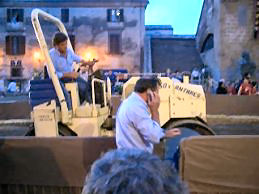
At this point I encountered a major camera malfunction. The menu started going whacky. I could not get it to do anything. Sue suggested removing the disk and putting it back in. This made no sense to me, but I let her do it. Sure enough, it immediately started behaving again. Maybe I would require more than two or three decades.
While I was cursing at and fiddling with my camera, everyone else was watching the blue team run the Palio course. It was just practice, but we had no way of knowing that. A rider (cavaliere) would approach a spot where a rope had been stretched overhead. From the rope were suspended two triangular banners, and at the bottom of each banner was a detachable plume (a ribbon, not a feather). Thirty or forty yards farther on were two urns perhaps a foot in diameter. The rider was supposed to grab the plume and then stuff it in the urn. When the real competition began, one rider would ride against another. The first one to get his plume in the urn won. If neither succeeded in potting the plume, there was no point.
Tom and Patti decided to walk over to the other side. They thought that they could get a better view. They ended up sitting on the stair steps. We stayed on the blue side. I found a spot to stand in the second row in the ideal position between the urns and the place where the plumes hung. As luck would have it, the people in front of me decided to leave. So I got to stand right on the rail. The judge’s stand was immediately on my left. The VIP’s were directly across from me. The only people with a better view than I had were the newspaper photographers. When Sue came by I gave her my spot so that she could take movies. I stood behind her and tried to take photos over her head.
The first competition was the Pagliotto, the purpose of which was to reward the best cavaliere. Each side picked its best four riders. Pistrella got off to a terrible start. Its first rider was disqualified. I am not sure what the infraction was; it might have been for icing or double dribble. Two young men in Pistrella tee shirts were standing right in front of me. They were extremely upset. One kicked the barrier in frustration. One of the next three blue riders somehow won on a technicality, but it certainly had appeared to me that they had all lost. At any rate, the remaining blue cavaliere was roundly defeated in the semi-final, which meant that two red guys rode against each other for the prize. The winner’s name was Cordolini or something like that.
The Cava fans were in ecstasy. They continually taunted Pistrella with something that looked like Florida State’s tomahawk chop. I couldn’t make out what they were chanting. The red team to me seemed to be full of pretty boys (and one pretty girl; Pistrella had one, too). The blue team seemed to be more “blue collar,” figuratively as well as literally.
Photographing the actual competitions turned out to be hopeless for someone of my extremely limited knowledge, experience, and skill. A spotlight behind the plumes ruined any photos taken in that direction. If I tried to use the night setting on my camera, everything was a blur because I could not hold the camera steady enough, and the horses were moving much too fast.
Next on the program was a parade of some medieval musicians. They featured a flag juggler, who was really quite talented. I must say, however, that the rest of the performance was not my cup of tea.
After the parade there was a long delay as they prepared the grounds for the big event. The Corcorans and most of the other members of our group thought that the show was over. They returned to the hotel. I noticed, however, that the captain of the blue team, Massimo, was very attentive to the placement of every bale of hay. Several small arguments ensued. It seemed clear to me that things had hardly begun.
Then a celebrity named Tina arrived. The announcer said that she was the “madrina” of the festival, but I could not catch what her claim to fame was. Her retinue seemed to include some members of her family – a sister maybe and some children. She was one of those Italian blondes with dark eyebrows. I noticed that she was hedging her bets. The color of her long purple gown was almost precisely halfway between the red of Cava and the blue of Pistrella.
Finally came the Palio itself. Each of the 12 riders on each team, this time wearing an off-white tunic with a scarf of the team color, rode against a rider from the other team. A point was awarded in each race in which one side or the other was able to get the plume into the urn. The announcer introduced both the rider and the horse. I found it interesting that he just gave the rider’s name, but he told how old each horse was and how much experience it had in previous Palios.
This time the Pistrella fans, who had been sitting on their hands all night, finally had something to cheer about. The blue guy won the first race. Before long it was 3-1. Then the rout was on. The final score was 8-2 in favor of Pistrella. Two races ended with no point awarded. The blue fans were extremely excited.
Sue took movies of both competitions, the medieval flag wavers, and the awarding of the Palio. Some of them featured appearances by Va Bene Bunny. I tried to take some still shots, but none of them would be likely to win a Pulitzer.
It was after 11:30 by the time that it was all over. We struggled through the crowd and made our way back to the hotel. The end of the race course in which the horses were kept was particularly fragrant. On the way home I discovered that the name of the place at which we had eaten supper the previous evening had the unlikely name of Café Maurice. No wonder the pizza was mediocre. Maybe we should have ordered escargot or crepes.
Note: Sue complained about the small size of the bathroom. She said that when she used the toilet, she had to put her legs under the sink and rest her boobs on it. self.focus()
